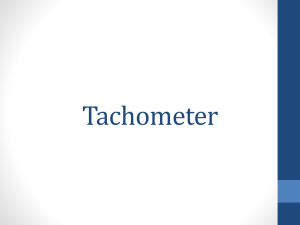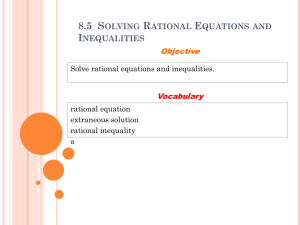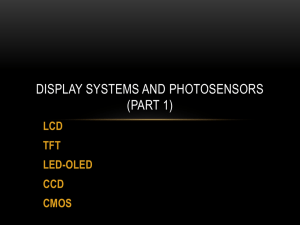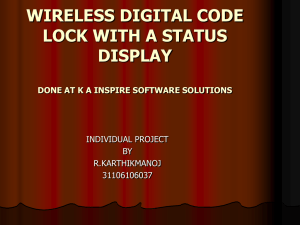Purdue Extension`s Leadership and Community Development
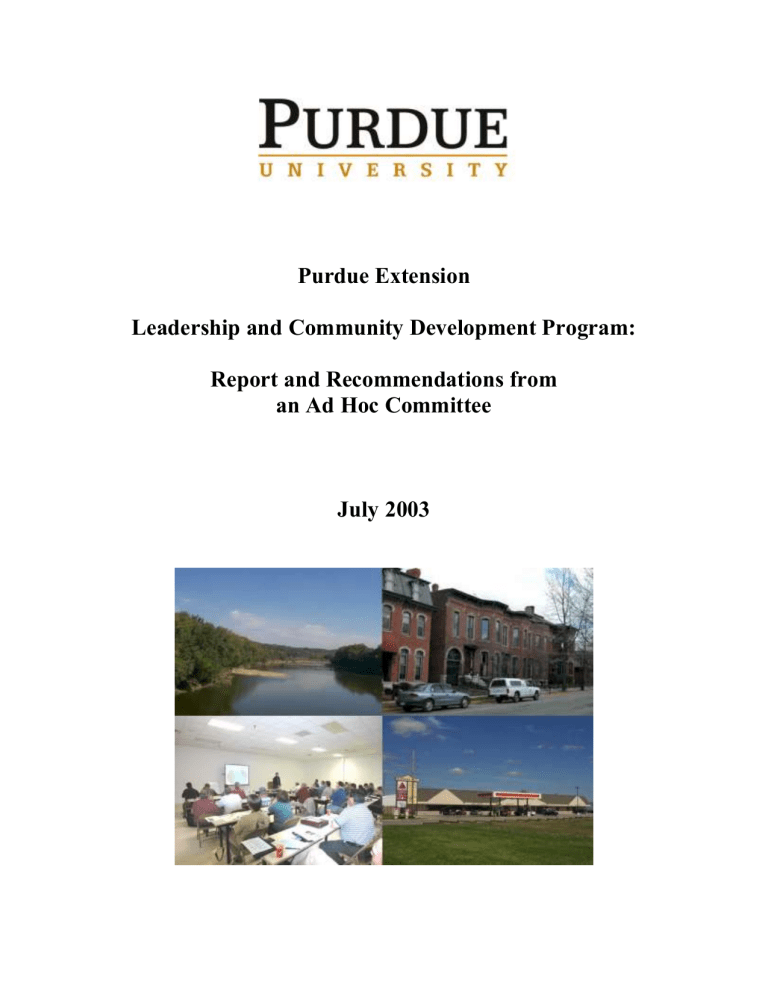
Purdue Extension
Leadership and Community Development Program:
Report and Recommendations from an Ad Hoc Committee
July 2003
Introduction, Background, and Acknowledgements
On May 13-14, 2003, a small group of internal stakeholders came together in a mini-retreat (at
Ft. Harrison) for the following purpose:
To develop a vision and strategic plan—with emphasis on staffing—for Extension’s
Leadership and Community Development (LCD) area of work.
There were several reasons for undertaking this task:
Many counties are feeling some pressure to do more in the LCD area;
Extension Administration is eager to support and strengthen the LCD program;
Purdue Extension is taking a hard look at how it is organized;
Economic development has become the mantra across the entire state and LCD programming has a major role and connection to economic development;
Forthcoming retirements in Purdue Extension create a special opportunity to consider
alternative staffing models; and
Special opportunities and responsibilities may emerge for Purdue Extension and the LCD area because of President Jischke’s emphasis on engagement and the creation of the new
Office of Engagement.
Dr. Dave Petritz, Director of Purdue Extension, was very supportive of this mini-retreat when it was first proposed to him by Sam Cordes, Program Leader for LCD. Director Petritz’s support and encouragement were crucial and appreciated greatly. The persons who participated in this mini-retreat were suggested by District Directors, Dr. Petritz, Program Leaders and others—and are listed in Attachment A. Many other highly qualified individuals were also suggested but a smaller group was needed to keep the process manageable. This did pose a challenge in terms of insuring representation from each Extension district and program area, as well as insuring adequate representation from campus. Other considerations were ethnic and gender diversity and variation in the experiential base of the participants. Joe Tutterrow, Director of the Indiana
Land Resources Council, served as the external facilitator and did an outstanding job in that role
(see Attachment B for the retreat agenda).
The balance of this report is divided into the following sections:
Assumptions
Strengths, Weaknesses, Opportunities and Threats
Key Findings and Recommendations
Expected Outcomes
Strategies, Tasks, and Action Steps
2
Assumptions
The LCD area of work has been around for a long time. Hence, while it is important to reflect on our vision and mission, and revise as needed, we are not starting from scratch.
Using an asset-based approach to build upon our strengths makes the most sense for
thinking about the future of the LCD program.
Visioning and planning are not a one-shot phenomenon and what is developed from this process needs to be constantly re-assessed, and adjusted as new challenges and opportunities arise.
Approximately 85 percent of Purdue’s Extension budget is allocated to personnel which suggests much of our planning needs to be linked to staffing.
While organization and structure are important there is not necessarily a single “best practice”. Stated differently, there may be several correct answers to any particular staffing
or planning question or issue.
The LCD plan must be in harmony with the basic tenets of the recently released “white paper” titled
Purdue Extension: Moving from Good to Great .
Lack of creativity is often a much bigger constraint than is the resource issue. Stated differently, sound and creative ideas and motivated people tend to have a way of finding
resources.
This Ad Hoc Committee is not expected to have long-term longevity.
Strengths, Weaknesses, Opportunities and Threats
Strengths
Most of the strengths in the LCD area are tied more generally to the broader strengths of Purdue
Extension: an office in every Indiana county; local grass-roots focus; strong local relationships; access to the local power structure; name recognition; perceived neutrality; trusted source of information; lots of good programs; access to national and international knowledge bases; distance education technologies; and talented and dedicated personnel. Two areas of strength specific to the LCD area is the in-depth knowledge that currently exists in community leadership and in state and local finance. The LCD program and personnel have made very significant positive impacts in many Indiana communities and neighborhoods over the years.
Unfortunately, many of these “success stories” are not well documented or have not received adequate recognition.
Weaknesses
Lack of a good working definition of LCD.
LCD is fragmented within Purdue Extension.
LCD has not been recognized as a legitimate programmatic area. This has generated a
cycle that feeds upon itself: lack of value leads to few resources, which leads to lack of impact, which reinforces the lack of value/recognition.
Very few dedicated resources relative to other programmatic areas.
Critical mass of resources is particularly lacking in certain essential sub-areas of work, e.g.,
economic development and community sociology/development.
Absence of a School of Public Administration within Purdue.
3
Strengths, Weaknesses, Opportunities and Threats (continued)
Opportunities
Timing – Purdue Extension is currently developing its strategic plan, giving serious thought to its future and how it is organized and operates, and will soon begin developing a new
five-year plan of work.
Purdue’s emphasis on engagement links nicely to the LCD area.
Educational and programming needs in the LCD area are greater than ever.
Economic development is widely embraced as the state’s top priority; and the General
Assembly has a very favorable impression of the contributions universities can make.
Workforce education represents a special opportunity for Extension.
New funds were recently appropriated at the state level for rural development and value-
added agriculture.
Many local economic development efforts of communities and neighborhoods—especially in smaller towns and rural areas—have limited capacity and will embrace additional
support and assistance from Purdue and Purdue Extension.
Recent and upcoming retirements can allow for some different staffing patterns.
Current dynamics and needs mean this is a good time to bring focus to the LCD area and to make the case for a re-energized program and resources.
Threats
Much of the LCD area of work does not fit Extension’s historic “expert model” of delivery
but involves more participatory community-based problem solving.
Impacts in this area of work are hard to measure, partly due to the long-term time frame required to measure final impacts.
The internal reward system (promotion, tenure, etc.) may not embrace this area of work.
Those who see the world as a zero-sum game (i.e., “win-lose” rather than “win-win”) will
not want this area of work to grow in stature.
Resistance to change and an inability to think “outside the box”.
Key Findings and Recommendations
A.
There is confusion within Purdue Extension as to what LCD is--and is not. For example, simply attending and participating in meetings of local service clubs and organizations is a valuable and important aspect of good citizenship (and can help identify programmatic opportunities) but is not an LCD program. As another example, the public relations role of the County Extension Director (CED) is not an LCD program. A strong LCD program is based on a body of scientifically-based knowledge that draws upon a variety of social sciences disciplines (e.g., sociology, economics, and community development) and certain professional schools (e.g., regional planning and public administration). Another distinguishing characteristic of this area of work is that it typically involves public issues where collective decisions are made—in contrast to the private decisions made by individuals, families, businesses, and organizations.
4
Key Findings and Recommendations (continued)
B.
Individuals with the type of education and training needed to operate at a high level of effectiveness in LCD programming tend to be extremely well-versed in the core “process competencies” we want in all of the Purdue Extension staff: facilitation; leadership; teamwork; collaboration; and multi-culturalism. Hence, a secondary role for the wellgrounded LCD professional is to be a resource to the rest of the Purdue Extension staff in the upgrading of these core competencies. Although LCD professionals are typically wellversed and well-skilled in process competencies that can be shared with other Extension staff, it does not follow that LCD is only about process. A strong and vibrant LCD program involves research-based strengths and competencies in both content and process.
C. Although the LCD area of work needs to be looked at holistically, it is also essential to recognize that fairly distinct elements comprise this larger mosaic. One approach to categorizing these different programmatic elements includes the following five foci:
Community planning and visioning
Economic and business development
Workforce development and related continuing education needs
Local government decision support
Civic engagement and community empowerment (community leadership development, public issues and conflict management, community capacity building and mobilization, and the development of entrepreneurial communities based on inclusion and social capital development)
Campus-level leadership needs to be formally identified for these various sub-areas of LCD work. Over the longer-run, additional capacity is needed to compliment the extremely small cadre of faculty who are currently working in the LCD area. Faculty/specialist priorities include the following: community economics; community development/sociology; and demography/multi-culturalism.
D. Extension staff that make a serious commitment to the LCD area are also very well-suited to be a critical entrée/liaison to Purdue’s broader engagement initiative.
E. Extension Educators need to think of different levels of involvement in their communities.
Level 1.
P
ublic relations in the community; and simple
P
articipation in community functions, boards, groups and organizations.
Level 2 .
P
resenting (what is available in LCD and Purdue).
P
romoting LCD.
P
articipation and
P
oint of involvement with engagement.
Level 3.
P
lanning for LCD programming and developing
P
artners for programming.
Level 4.
P
rogram development, delivery and
P
edagogy in LCD.
P
articipatory learning and
P
roblem-solving with (not for) communities, neighborhoods, and organizations.
5
Key Findings and Recommendations (continued)
F. ALL Educators—and especially the CED—can and should do Level 1. However, Educators who carry the LCD title must, as a minimum, operate at Level 2 and Level 3. If they are to be promoted in the LCD area they must also operate at Level 4. This does not preclude
Educators who do not have the LCD title from working at Levels 2, 3, and 4 should they have the interest and competency.
G. Our current LCD effort is not really a program. For example, various people hold the LCD title but never go beyond Level 1. While all program areas need additional resources, the
LCD area is particularly weak—perhaps no more than a half dozen Educators are doing
Level 4 work and there are only 4-5 specialists on campus in the LCD area (and most of these campus faculty have only a small proportion of their time dedicated to Extension). A systematic and well-designed professional development program is needed for those
Educators who aspire to carry the LCD title and work at Levels 3 and 4.
H. It is a missed opportunity for Purdue Extension if we don’t enhance the LCD area of work.
Conversely, if we can enhance this area, our entire Purdue Extension system will benefit because this area of work is uniquely positioned to reach new audiences and answer the critics who say Extension never changes and is too traditional. Second, it represents a natural linkage to the engagement thrust of the University and to the statewide priority on economic development.
I. There is too much of a silo mentality associated with our four programmatic areas. Linkages and synergy between the LCD area and the other three programmatic areas needs to be aggressively pursued.
J.
Not enough use is made of flexible and nontraditional approaches to staffing and acquiring expertise. In many case, as specific issues and opportunities emerge it is important to explore alternatives to making a virtual life-time commitment to having our “own” personnel. Examples of alternatives include leveraging of resources at the state and local levels; the sharing of staff with other agencies, organizations and universities; and making appropriate use of consultants, short-term contracts, non-tenure track faculty, and visiting professors.
K. As we begin to build an LCD program we need to have a more formal way of identifying and supporting the specific programmatic needs in the counties. It may be important initially to have a special local advisory committee with cross-representation from the Extension Board
(or perhaps organized as a subcommittee of the Extension Board).
6
Key Findings and Recommendations (continued)
L. Staffing Recommendation
In the near-term, efforts need to be initiated to have at least one highly qualified full-time LCD professional serving each of Purdue Extension’s 10 geographic areas. Each Area Educator would have two roles:
1.
Develop and deliver, in conjunction with county-based staff, programmatic offerings in the five targeted foci noted above (see item C above). In addition to this “generalist” role, the Area Educator will be expected to have specialized capacity it at least one of the five foci noted above and could be viewed as a multi-area (or even multi-district) resource in that particular foci.
2.
Serve as an internal resource for developing and upgrading the “process competencies” of
Educators.
The presence of Area Educators will not diminish, but will enhance, the need for county-based
Educators working in the LCD area (who may serve more than one county). Indeed, Area
Educators will be a critical resource to strengthen and support county-based Educators working in the LCD area—especially for those Educators interested in moving their competency to
Levels 3 and 4. County-based Educators who make a serious commitment to this level of LCD programming will be expected to make a heavy investment in professional growth and development.
Purdue Extension should aspire to become the best LCD Extension program in the country, a distinction currently held by the University of Wisconsin. The type of staffing arrangement and investment in professional development noted above will put that goal within our grasp.
M. A number of important organizational issues need to be addressed and adjusted as necessary, including the following:
Should the name of this programmatic area be changed to something other than Leadership
and Community Development? If so, what are the alternatives?
The current organizational structure for the LCD program includes three sub-units: the
LCD Task Force, the Leadership Team, and the Land Use Team. Is this the optimum organizational structure? How do these groups relate to one another and to other groups within Extension, e.g., the New Ventures Team and the NELD group? Are the size and composition of these three sub-units appropriate? Are their missions clear? How should
leadership and membership be rotated/refreshed?
What is/should be the role of the LCD Program Leader in the evaluation of staff who have
LCD responsibilities? What should be the reporting and evaluation process for Area
Educators?
7
Expected Outcomes of a Statewide Team of Area and County-Based
Extension Educators Strategically Linked to Campus Resources
Specific impact targets are beyond the scope of this report. However, the scholarly literature, and experience from other states, strongly suggest that a strong research-based LCD program makes a real difference in the vitality of communities and neighborhoods.
Improved Futures.
Community wide visioning and planning create a road map of future possibilities, strategies, and tactics and action plans to allow communities and areas to create the type of community they want for themselves and their children.
Stronger Economies.
Education, applied research and technical assistance in the economic, business and workforce development areas are important ingredients in enhancing profitability, revitalizing lagging local economies, enhancing economic opportunities and creating higher quality jobs at the local level.
Strengthening Local Government.
Providing decision-support tools, information, and educational programming for local government officials enhances local decision making and increases public participation and civic engagement within the community.
Increased Long-term Local Capacity. If local and areawide economies are to thrive, communities, businesses and industries need to do take the initiative and leadership.
Consultants and "experts" should only inform and build upon local capacity. Extension's emphasis on learning, discovery and engagement adds long-term value and capacity to local economic and community development efforts. The effects are felt long after the initial issue, problem or project has been addressed. This long-term capacity is further enhanced by
Extension's targeted and inclusive programs that build broad-based leadership skills and civic engagement capabilities throughout the community.
Enhanced Impact and Image for Purdue.
Successfully executing this agenda and staffing plan will:
Contribute to the economic development and future of Indiana;
Broaden Extension's portfolio;
Provide an important interface between Purdue Extension and Engagement;
Create new and important opportunities for Purdue and Purdue Extension to engage in meaningful partnerships at both the local and statewide levels; and
Expand the opportunities for Purdue faculty, staff and students to become engaged in participatory community-based problem solving.
8
Strategies, Tasks and Action Steps
Share this document with the Extension Director, Extension Administrative Staff, the LCD Task
Force, the Vice Provost for Engagement and other stakeholders. Input, response and suggestions received will be part of an ongoing planning and reflection process—and as a road map for the future of the LCD program. Assuming no major changes are necessitated immediately in the overall tenor and direction of this document, some of the tasks and activities that will need to be further developed or implemented follow (not listed in any type of priority ordering):
1.
Develop a short statement (primarily for internal educational purposes) that describes what the LCD program is and is not (see items A, C and E above).
2.
Pursue opportunities to bring the vision of Area Educators to fruition. Leveraging and partnering within the University and with potential external partners (e.g., the Indiana
Rural Development Commission, Ball State, regional planning and development organizations, and the Indiana Department of Commerce) will be one aspect of this strategy. Develop a more detailed statement of expected outcomes that would be envisioned if the full compliment of Area Educators were in place. Develop a prototype position description for the Area Educator concept. NOTE: This task has already been completed (see Attachment C).
3.
Facilitate a discussion that focuses on the evolution, linkages, and synergy between Purdue
Extension and the broader engagement effort (see items D and H above).
4.
Identify faculty leadership for the LCD sub-areas of work and over the long-run identify opportunities for enhancing the campus base of support (see items C, G, and J above).
5.
Initiate discussion and dialogue with the Program Leaders and faculty and staff in the other programmatic areas to identify synergistic opportunities between LCD and the other three program areas (see item I above). Potential areas of exploration include human resource development, multi-cultural issues, leadership, environmental and natural resource issues, small business development, youth entrepreneurship, and the work of the
New Ventures Team.
6.
Identify Educators who are interested in and willing to contribute to LCD programming at
Levels 2, 3, and 4—and in concert with Director Directors and other stakeholders, support and facilitate needed professional development (see items E, F, and G above). Develop a prototype position description for an Educator who focuses on LCD programming.
NOTE: This task has already been completed (see Attachment D).
7.
Systematically identify and develop professional development programs, curricula and opportunities for Educators who make a commitment to the LCD area—especially if they are operating or aspire to operate at Level 4 (see items E, F, and G above).
8.
Work with the Extension Director, District Directors and others to formalize a structure/process by which additional direction can be given at the local level to LCD programming and to the connection to Purdue’s broader engagement effort (see item D, H and K above).
9.
Revisit and refine as needed the vision and mission statement for the LCD area.
9
Strategies, Tasks and Action Steps (continued)
10.
Address the following organizational questions and issues (see item M above):
Better define and possibly restructure the current organizational structure for LCD.
Clarity is needed regarding the roles, communications, coordination, leadership, membership and linkages among the LCD Task Force, Leadership Team, Land Use
Team, NELD, etc.
Determine whether or not to change the name of the programmatic area.
Engage in a dialogue about the role of the LCD Program Leader in the evaluation of staff who have LCD responsibilities? If Area Educators are hired what should be the reporting and evaluation process?
11.
Continue work on the development of a LCD website. One aspect of this may be a series of popularized “success stories” that illustrate how Extension’s LCD program can be of help to local communities. This information can also be useful in helping to document impacts, including impacts that may have a gestation period of several years or more.
12.
Consider the development of a publication series in the LCD area.
10
ATTACHMENT A: Mini-Retreat Participants
Facilitator:
Joe Tutterrow
Director, Indiana Land Resources Council
Office of the Commissioner of Agriculture
ISTA Center, Suite 414
150 West Market Street
Indianapolis, IN 46204
Telephone: 317-234-5262
Fax: 317-232-1362
Email: jtutterrow@commerce.state.in.us
Participants:
Janet Ayres
Professor, Agricultural Economics
Purdue University
403 W. State Street
Krannert Building
West Lafayette, IN 47907-2056
Telephone: 765-494-4215
Fax: 765-494-9176
Email: ayres@purdue.edu
Sam Cordes
LCD Program Leader
Purdue University Extension
175 Marsteller Street
Forest Products Building, Room 201
West Lafayette, IN 47907-2033
Telephone: 765-494-3573
Fax: 765-496-6026
Email: smcordes@purdue.edu
Natalie Fowler
Interim Southeast District Director
Purdue University Extension
Dearborn County Office
City Hall
233 Main Street
Aurora, IN 47001-1385
Telephone: 812-522-6769
Fax: 812-926-3006
Email: nfowler@purdue.edu
Rick Chase
District Director
Purdue University Extension
Central District Office
100 International Drive, Suite B
Franklin, IN 46131-9641
Telephone: 317-736-7842
Fax: 317-738-4962
Email: rchase@purdue.edu
Karen DeZarn
Assistant Program Leader for CFS
Purdue University Extension
812 W. State Street
Matthews Hall
West Lafayette, IN 47907-2060
Telephone: 765-494-8252
Fax:
Email: kdezarn@purdue.edu
Merrily Hamp
CED, LaGrange County
Purdue University Extension
LaGrange County Office Building
114 W. Michigan Street, Suite 10
LaGrange, IN 46761-1889
Telephone: 260-499-6334
Fax: 260-499-6398
Email: mhamp@purdue.edu
11
John Hancewicz
CED, Vigo County
Purdue University Extension
Vigo County Office
275 Ohio Street
Terre Haute, IN 47807-3495
Telephone: 812-462-3371
Fax: 812-238-9980
Email: hank@purdue.edu
John Huie
Professor, Agricultural Economics
Special Assistant to the President
Purdue University
403 W. State Street
Krannert Building
West Lafayette, IN 47907-2056
Telephone: 765-494-4298
Fax: 765-494-9176
Email: huie@purdue.edu
Bryan Metzger
CED, Tippecanoe County
Purdue University Extension
Tippecanoe County Office
3150 Sagamore Parkway South
Lafayette, IN 47905-5156
Telephone: 765-474-0793
Fax: 765-474-5330
Email: bmetzger@purdue.edu
George Okantey
Extension Educator
Purdue University Extension
Marion County Office
6640 Intech Blvd., Ste. 120
Indianapolis, IN 46278-2012
Telephone: 317-275-9305
Fax: 317-275-9309
Email: okantey@purdue.edu
Judith Hauser
Extension Educator
Purdue University Extension
Jasper County Office
122 N. Cullen
Rensselaer, IN 47978-2644
Telephone: 219/866-5741
Fax: 219/866-4962
Email: jhauser@purdue.edu
David McKinnis
Director, Technical Assistance Program
Purdue University
1435 Win Hentchel Blvd.
Vision Technology
Suite B-110
West Lafayette, IN 47907-4148
Telephone: 765-494-9189
Fax: 765-494-9187
Email: mckinnis@purdue.edu
Jerry Nelson
Extension Educator
Purdue University Extension
Knox County Office
Hillcrest Building
2758D East Pine Hill Drive
Vincennes, IN 47591-2503
Telephone: 812-882-3509
Fax: 812-882-3537
Email: jnelson@purdue.edu
12
ATTACHMENT B
Mini-Retreat for Extension Leadership and Community Development
2:00 Round robin on expectations/issues to be addressed at retreat
2:30 Review organizational context/parameter
Extension—Sam
May 13-14, 2003
Tentative Agenda
Tuesday, May 13
1:30 Convene, welcome, and charge to group—Sam
1:45 Roles, goals, expectations, ground rules—Joe
Engagement—Dave
3:00 Break
3:15 Environmental scan (SWOT of LCD area)
4:15 Thinking about the subareas within LCD—Sam
5:00 Recess
5:30 Group dinner
7:00 Brainstorming on resource acquisition and deployment.
Central question: what are alternative models for staffing in the LCD area?
9:00 Recess for evening
Wednesday, May 14
7:30 Group breakfast
8:30 Narrowing the discussion of alternative staffing models
Implications of the different models for program delivery, staff development
and other relevant considerations
Creative ways of acquiring and leveraging resources
Opportunities for building and sustaining partnerships
What is the “ideal” staffing model for our long-range vision?
What is the best (or the two best) short-term staffing pattern(s)/model(s) that is consistent with our long-term vision
10:00 Break
10:15 Important collateral issues
Organizational structure, relationships and alignment
Title of program area
Other
11:30 Working (box) lunch in meeting room
Noon Pulling it all together
Identification of action steps, strategies, and tactics
Who, what and when regarding follow-up activities?
Role and next steps for the ad hoc planning group
Other
2:15 Summarization and reflections
2:30 Adjourn
13
ATTACHMENT C
Qualifications, Competencies and Expectations/Role of LCD Area Educators
(July 2003 Draft)
Qualifications: Successful applicants must hold at least a masters degree (or equivalent) in business, economics, public affairs, community development, public administration, sociology, regional planning or related social science or professional field. 3-5 years relevant experience beyond the masters degree is preferred.
Competencies:
Strong scholarship-based knowledge and expertise in the broad area of leadership and community development with specialized capacity in at least one of the following areas: community planning and visioning; economic and business development; workforce development and related continuing education needs; local government and decision
support; and civic engagement and community empowerment.
Knowledge, skills and leadership capacity to design, implement and evaluate researchbased educational programs and processes, and training and engagement projects.
Ability to work effectively with audiences historically underserved by Extension.
Knowledge skills and leadership capacity to engage in high quality applied research that is
supportive of relevant educational and engagement needs.
Skills in developing and maintaining effective working relationships with colleagues,
partners and stakeholders.
Ability to use technology for communications, information finding, program delivery and reporting.
Skills and capacity as a public entrepreneur who is effective and creative in acquiring nontraditional sources of funding and support to build sustainable programmatic activities.
Strong project management skills and capabilities.
Motivation and commitment to professional development, including keeping abreast of recent research developments and findings in the LCD area.
Expectations/Role:
Provide area-wide leadership for the LCD program.
Support and coach county-based Educators in the initiation, design, implementation and evaluation of a vibrant and sustainable LCD program that is customized and relevant to the
local area.
Play a major role in the delivery of educational programs, workshops and technical assistance services that are consistent with the county based LCD program/plan.
Work with campus faculty and others in the development and adaptation of curricula and related educational materials.
Develop regional collaborative arrangements and partnerships that will (a) increase the
impact of programs and activities (b) generate funding and support for programs and activities and (c) insure long-term sustainability.
Engage in applied research that is supportive of area-wide educational programming.
Serve as a statewide resource in one of the five specialty areas.
Serve as an active participant in relevant statewide, regional and national professional development organizations and societies.
14
ATTACHMENT D
Qualifications, Competencies and Expectations/Role of LCD County Based
Extension Educators (July 2003 Draft)
Qualifications: Successful applicants much hold at least a masters degree (or equivalent).
Preference is given to those holding at least one degree (or a minor) in business, economics, public affairs, community development, public administration, sociology, regional planning or related social science or professional field.
Competencies: The general competencies expected of all Extension Educators are important, with the following competencies being of special importance.
Ability and skills to engage in community needs assessment and asset
identification/mobilization.
Ability to work effectively with audiences historically underserved by Extension.
Ability and skills to understand complex local issues and how local social and community systems function.
Skills and capacity to engage in effective facilitation, group decision making, conflict
management and participatory community problem solving.
Ability to use technology for communications, information finding, program delivery and
reporting.
Skills and capacity as a public entrepreneur who is effective and creative in acquiring nontraditional sources of funding and support for building sustainable programmatic activities.
Skills and capacity in basic educational methods and communications.
Willingness to engage in ongoing professional development opportunities to increase understanding and competency in the targeted subject-matter components of LCD programming.
Expectations/Role:
To provide local Extension leadership in the creation and implementation of a vibrant and sustainable LCD program and plan of work that is customized and relevant to the local
area.
To contribute to the development of curriculum and in the pedagogical component of program delivery, including involvement in the teaching role (typically in conjunction with
campus specialists or Area Educators).
To build local relationships, partnerships and support to increase the impact and sustainability of research-based community, economic, and leadership development
services and programs.
To communicate and promote to local audiences the programs and resources available in the LCD programmatic area and in Purdue’s broader engagement effort.
To provide local logistical and administrative support for selected educational programs and services, e.g., publicity and recruitment of participants, registration and evaluation. To facilitate and serve as a resource broker for community-based initiatives in the area of
community, economic and leadership development.
To serve as the primary local contact for Purdue's university-wide engagement effort.
15

